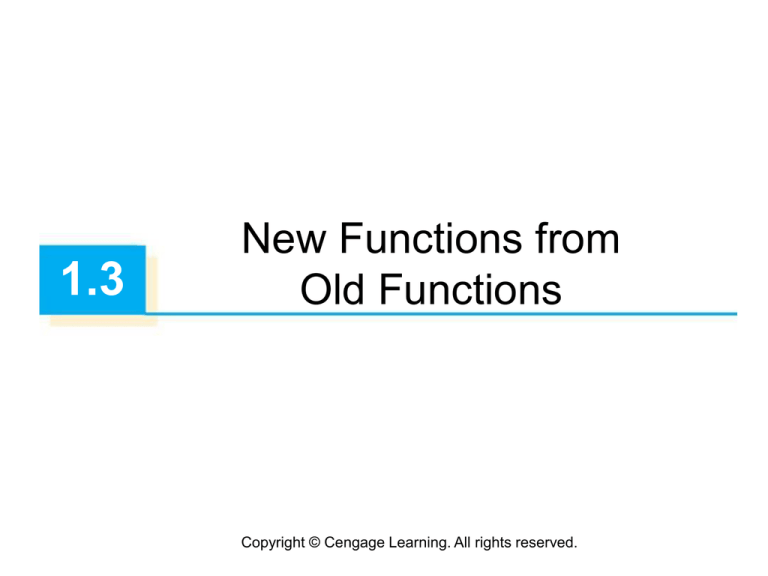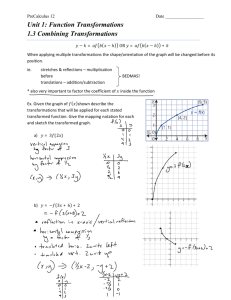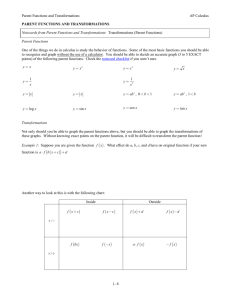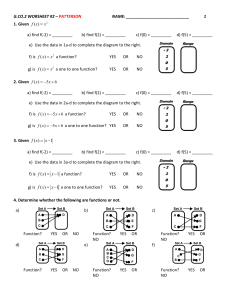
1.3
New Functions from
Old Functions
Copyright © Cengage Learning. All rights reserved.
Transformations of Functions
3
Transformations of Functions
By applying certain transformations to the graph of a given
function we can obtain the graphs of certain related
functions.
This will give us the ability to sketch the graphs of many
functions quickly by hand. It will also enable us to write
equations for given graphs.
Let’s first consider translations. If c is a positive number,
then the graph of y = f(x) + c is just the graph of y = f(x)
shifted upward a distance of c units (because each
y-coordinate is increased by the same number c).
4
Transformations of Functions
Likewise, if g(x) = f(x – c), where c > 0, then the value of
g at x is the same as the value of f at x – c (c units to the left
of x).
Therefore the graph of
y = f(x – c), is just the
graph of y = f(x) shifted
c units to the right
(see Figure 1).
Translating the graph of ƒ
Figure 1
5
Transformations of Functions
Now let’s consider the stretching and reflecting
transformations. If c > 1, then the graph of y = cf(x) is the
graph of y = f(x) stretched by a factor of c in the vertical
direction (because each y-coordinate is multiplied by the
same number c).
6
Transformations of Functions
The graph of y = –f(x) is the graph of y = f(x) reflected about
the x-axis because the point (x, y) is replaced by the
point (x, –y).
(See Figure 2 and the
following chart, where the
results of other stretching,
shrinking, and reflecting
transformations are also
given.)
Stretching and reflecting the graph of f
Figure 2
7
Transformations of Functions
8
Transformations of Functions
Figure 3 illustrates these stretching transformations when
applied to the cosine function with c = 2.
Figure 3
9
Transformations of Functions
For instance, in order to get the graph of y = 2 cos x we
multiply the y-coordinate of each point on the graph of
y = cos x by 2.
This means that the graph of y = cos x gets stretched
vertically by a factor of 2.
10
Combinations of Functions
14
Combinations of Functions
Two functions f and g can be combined to form new
functions f + g, f – g, fg, and f/g in a manner similar to the
way we add, subtract, multiply, and divide real numbers.
The sum and difference functions are defined by
(f + g)(x) = f(x) + g(x)
(f – g)(x) = f(x) – g(x)
If the domain of f is A and the domain of g is B, then the
domain of f + g is the intersection A ∩ B because both
f(x) and g(x) have to be defined.
For example, the domain of
is A = [0, ) and the
domain of
is B = (
, 2], so the domain of
is A ∩ B = [0, 2].
15
Combinations of Functions
Similarly, the product and quotient functions are defined by
The domain of fg is A ∩ B, but we can’t divide by 0 and so
the domain of f/g is {x A ∩ B | g(x) 0}.
For instance, if f(x) = x2 and g(x) = x – 1, then the domain of
the rational function (f/g)(x) = x2/(x – 1) is {x | x 1},
or (
, 1) U (1, ).
16
Combinations of Functions
There is another way of combining two functions to obtain a
new function. For example, suppose that y = f(u) =
and u = g(x) = x2 + 1.
Since y is a function of u and u is, in turn, a function of x, it
follows that y is ultimately a function of x. We compute
this by substitution:
y = f(u) = f(g(x)) = f(x2 + 1) =
The procedure is called composition because the new
function is composed of the two given functions f and g.
17
Combinations of Functions
In general, given any two functions f and g, we start with a
number x in the domain of g and find its image g(x). If this
number g(x) is in the domain of f, then we can calculate the
value of f(g(x)).
The result is a new function h(x) = f(g(x)) obtained by
substituting g into f. It is called the composition
(or composite) of f and g and is denoted by f g (“f circle g”).
18
Combinations of Functions
The domain of f g is the set of all x in the domain of g such
that g(x) is in the domain of f.
In other words, (f g)(x) is
defined whenever both
g(x) and f(g(x)) are defined.
Figure 11 shows how to
picture f g in terms of machines.
The f g machine is composed of
the g machine (first) and then
the f machine.
Figure 11
19
Combinations of Functions
Remember, the notation f g means that the function g is
applied first and then f is applied second. In Example 6,
f g is the function that first subtracts 3 and then squares;
g f is the function that first squares and then subtracts 3.
It is possible to take the composition of three or more
functions. For instance, the composite function f g h is
found by first applying h, then g, and then f as follows:
(f g h)(x) = f(g(h(x)))
21


![Pre-Calculus Section 2.4 Worksheet [Day 2] Name: Sept 2013](http://s3.studylib.net/store/data/009631193_1-e3d94798b333927b8838d35592e3c417-300x300.png)


